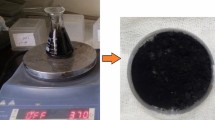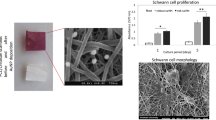Abstract
Fabrication method is one of the essential factors which directly affect on the properties of scaffold. Several techniques have been well established to fabricate nanofibrous scaffolds such as electrospinning. However, preparing a three-dimensional (3-D) interconnected macro-pore scaffold essential for transporting the cell metabolites and nutrients is difficult using the electrospinning method. The main aim of this study was developing a highly porous scaffold by poly (L-lactic acid) (PLLA)/chitosan blend using liquid–liquid phase separation (LLPS) technique, a fast and cost–benefit method, in order to use in nerve tissue engineering. In addition, the effect of different polymeric concentrations on morphology, mechanical properties, hydrophilicity, in vitro degradation rate and pH alteration of the scaffolds were evaluated. Moreover, cell attachment, cell viability and cell proliferation of scaffolds as candidates for nerve tissue engineering was investigated. PLLA/chitosan blend not only had desirable structural properties, porosity, hydrophilicity, mechanical properties, degradation rate and pH alteration but also provided a favorable environment for attachment, viability, and proliferation of human neuroblastoma cells, exhibiting significant potential for nerve tissue engineering applications. However, the polymeric concentration in blend fabrication had influence on both characteristics and cell responses. It concluded that PLLA/chitosan nanofibrous 3-D scaffold fabricated by LLPS method as a suitable candidate for nerve tissue engineering.




Similar content being viewed by others
References
Bastami, F., & Khojasteh, A. (2016). Use of leukocyte-and platelet-rich fibrin for bone regeneration: a systematic review regeneratio. Regeneration Reconstruction & Restoration, 1, 47–68.
Bastami, F., Paknejad, Z., Jafari, M., Salehi, M., Rad, M. R., & Khojasteh, A. (2016). Fabrication of a three-dimensional β-tricalcium-phosphate/gelatin containing chitosan-based nanoparticles for sustained release of bone morphogenetic protein-2: Implication for bone tissue engineering. Materials Science and Engineering C, 72, 481–491.
Bastami, F., Vares, P., & Khojasteh, A. (2016). Healing Effects of Platelet-Rich Plasma on Peripheral Nerve Injuries. Journal of Craniofacial Surgery, 28(1), 49–57.
Bastami, F., Vares, P., & Khojasteh, A. (2017). Healing effects of platelet-rich plasma on peripheral nerve injuries. Journal of Craniofacial Surgery, 28, e49–e57.
Carrubba, V., Pavia, F. C., Brucato, V., & Piccarolo, S. (2008). PLLA/PLA scaffolds prepared via thermally induced phase separation (TIPS): Tuning of properties and biodegradability. International Journal of Material Forming, 1, 619–622. https://doi.org/10.1007/s12289-008-0332-5
Chen, C., Dong, L., & Cheung, M. K. (2005). Preparation and characterization of biodegradable poly(l-lactide)/chitosan blends. European Polymer Journal, 41, 958–966. https://doi.org/10.1016/j.eurpolymj.2004.12.002
Chen, L., et al. (2013). Electrospun poly (L-lactide)/poly (ε-caprolactone) blend nanofibrous scaffold: characterization and biocompatibility with human adipose-derived stem cells. PLoS ONE, 8(8), e71265.
Chen, S., He, Z., Xu, G., & Xiao, X. (2016). Fabrication and characterization of modified nanofibrous poly (L-lactic acid) scaffolds by thermally induced phase separation technique and aminolysis for promoting cyctocompatibility. Journal of Biomaterials Science Polymer Edition, 27, 1058–1068.
Chen, S., Zhao, X., & Du, C. (2018). Macroporous poly (l-lactic acid)/chitosan nanofibrous scaffolds through cloud point thermally induced phase separation for enhanced bone regeneration. European Polymer Journal, 109, 303–316.
Dahlin, L., Johansson, F., Lindwall, C., & Kanje, M. (2009). Future perspective in peripheral nerve reconstruction. International Review of Neurobiology, 87, 507–530.
Duarte, A. R. C., Mano, J. F., & Reis, R. L. (2010). Novel 3D scaffolds of chitosan–PLLA blends for tissue engineering applications: Preparation and characterization. The Journal of Supercritical Fluids, 54, 282–289. https://doi.org/10.1016/j.supflu.2010.05.017
Edlund, U., Sauter, T., & Albertsson, A. C. (2011). Covalent VEGF protein immobilization on resorbable polymeric surfaces. Polymers for Advanced Technologies, 22, 166–171.
Evans, G. R. (2001). Peripheral nerve injury: A review and approach to tissue engineered constructs. The Anatomical Record, 263, 396–404.
Farokhi, M., Mottaghitalab, F., Shokrgozar, M. A., Kaplan, D. L., Kim, H.-W., & Kundu, S. C. (2017). Prospects of peripheral nerve tissue engineering using nerve guide conduits based on silk fibroin protein and other biopolymers. International Materials Reviews, 62, 367–391.
Ghasemi-Mobarakeh, L., Prabhakaran, M. P., Morshed, M., Nasr-Esfahani, M.-H., & Ramakrishna, S. (2008). Electrospun poly (ɛ-caprolactone)/gelatin nanofibrous scaffolds for nerve tissue engineering. Biomaterials, 29, 4532–4539.
Ghasemi-Mobarakeh, L., Prabhakaran, M. P., Morshed, M., Nasr-Esfahani, M.-H., & Ramakrishna, S. (2008). Electrospun poly(ɛ-caprolactone)/gelatin nanofibrous scaffolds for nerve tissue engineering. Biomaterials, 29, 4532–4539. https://doi.org/10.1016/j.biomaterials.2008.08.007
Habre, S. B., Bond, G., Jing, X. L., Kostopoulos, E., Wallace, R. D., & Konofaos, P. (2018). The surgical management of nerve gaps: Present and future. Annals of Plastic Surgery, 80, 252–261.
Ho, S. T., & Hutmacher, D. W. (2006). A comparison of micro CT with other techniques used in the characterization of scaffolds. Biomaterials, 27, 1362–1376. https://doi.org/10.1016/j.biomaterials.2005.08.035
Holzwarth, J. M., & Ma, P. X. (2011). Biomimetic nanofibrous scaffolds for bone tissue engineering. Biomaterials, 32, 9622–9629.
Hua, F. J., Kim, G. E., Lee, J. D., Son, Y. K., & Lee, D. S. (2002). Macroporous poly (L-lactide) scaffold 1. Preparation of a macroporous scaffold by liquid–liquid phase separation of a PLLA–dioxane–water system. Journal of Biomedical Materials Research, 63, 161–167.
Hua, F. J., Kim, G. E., Lee, J. D., Son, Y. K., & Lee, D. S. (2002). Macroporous poly(L-lactide) scaffold 1. Preparation of a macroporous scaffold by liquid–liquid phase separation of a PLLA–dioxane–water system. Journal of Biomedical Materials Research, 63, 161–167.
Jeon, S., Karkhanechi, H., Fang, L.-F., Cheng, L., Ono, T., Nakamura, R., & Matsuyama, H. (2018). Novel preparation and fundamental characterization of polyamide 6 self-supporting hollow fiber membranes via thermally induced phase separation (TIPS). Journal of Membrane Science, 546, 1–14.
Khojasteh, A., et al. (2016). Development of PLGA-coated β-TCP scaffolds containing VEGF for bone tissue engineering. Materials Science and Engineering C, 69, 780–788.
La Carrubba, V., Pavia, F. C., Brucato, V., & Piccarolo, S. (2008). PLLA/PLA scaffolds prepared via Thermally Induced Phase Separation (TIPS): tuning of properties and biodegradability International. Journal of Material Forming, 1, 619–622.
Li, X.-T., Zhang, Y., & Chen, G.-Q. (2008). Nanofibrous polyhydroxyalkanoate matrices as cell growth supporting materials. Biomaterials, 29, 3720–3728.
Lim, J. I., Im, H., & Lee, W.-K. (2015). Fabrication of porous chitosan-polyvinyl pyrrolidone scaffolds from a quaternary system via phase separation Journal of Biomaterials Science. Polymer Edition, 26, 32–41.
Meyer, C., et al. (2016). Chitosan-film enhanced chitosan nerve guides for long-distance regeneration of peripheral nerves. Biomaterials, 76, 33–51.
Mohamadi, F., et al. (2017). Electrospun nerve guide scaffold of poly (ε-caprolactone)/collagen/nanobioglass: An in vitro study in peripheral nerve tissue engineering. Journal of Biomedical Materials Research Part A, 105, 1960–1972.
Panseri, S., et al. (2008). Electrospun micro-and nanofiber tubes for functional nervous regeneration in sciatic nerve transections. Bmc Biotechnology, 8, 1.
Prabaharan, M., Rodriguez-Perez, M. A., de Saja, J. A., & Mano, J. F. (2007). Preparation and characterization of poly(L-lactic acid)-chitosan hybrid scaffolds with drug release capability. Journal of Biomedical Materials Research Part B Applied Biomaterials, 81B, 427–434. https://doi.org/10.1002/jbm.b.30680
Ranjbar-Mohammadi, M., Prabhakaran, M. P., Bahrami, S. H., & Ramakrishna, S. (2016). Gum tragacanth/poly (l-lactic acid) nanofibrous scaffolds for application in regeneration of peripheral nerve damage. Carbohydrate Polymers, 140, 104–112.
Rasal, R. M., Janorkar, A. V., & Hirt, D. E. (2010). Poly(lactic acid) modifications. Progress in Polymer Science, 35, 338–356. https://doi.org/10.1016/j.progpolymsci.2009.12.003
Rotter, N., Bücheler, M., Haisch, A., Wollenberg, B., & Lang, S. (2007). Cartilage tissue engineering using resorbable scaffolds. Journal of Tissue Engineering and Regenerative Medicine, 1, 411–416.
Salehi, M., & Bastami, F. (2016). Characterization of wet-electrospun poly (ε-caprolactone)/poly (L-lactic) acid with calcium phosphates coated with chitosan for bone engineering regeneration. Reconstruction & Restoration, 1, 69–74.
Salehi, M., Farzamfar, S., Bastami, F., & Tajerian, R. (2016). Fabrication and characterization of electrospun PLLA/collagen nanofibrous scaffold coated with chitosan to sustain release of aloe vera gel for skin tissue engineering. Biomedical Engineering Applications Basis and Communications, 28, 1650035.
Salehi, M., Naseri Nosar, M., Amani, A., Azami, M., Tavakol, S., & Ghanbari, H. (2015). Preparation of pure PLLA, pure chitosan, and PLLA/Chitosan blend porous tissue engineering scaffolds by thermally induced phase separation method and evaluation of the corresponding mechanical and biological properties. International Journal of Polymeric Materials and Polymeric Biomaterials, 64, 675–682.
Scherman, P., Kanje, M., & Dahlin, L. B. (2003). Bridging short nerve defects by direct repair under tension, nerve grafts or longitudinal sutures. Restorative Neurology and Neuroscience, 22, 65–72.
Schugens, C., Maquet, V., Grandfils, C., Jerome, R., & Teyssie, P. (1996). Polylactide macroporous biodegradable implants for cell transplantation. II Preparation of polylactide foams by liquid-liquid phase separation. Journal of Biomedical Materials Research, 30, 449–461.
Shao, J., Chen, C., Wang, Y., Chen, X., & Du, C. (2012). Early stage structural evolution of PLLA porous scaffolds in thermally induced phase separation process and the corresponding biodegradability and biological property. Polymer Degradation and Stability, 97, 955–963. https://doi.org/10.1016/j.polymdegradstab.2012.03.014
Vasita, R., & Katti, D. S. (2006). Nanofibers and their applications in tissue engineering. International Journal of Nanomedicine, 1, 15.
Vieira, A. C., Vieira, J. C., Ferra, J. M., Magalhães, F. D., Guedes, R. M., & Marques, A. T. (2011). Mechanical study of PLA–PCL fibers during in vitro degradation. Journal of the Mechanical Behavior of Biomedical Materials, 4, 451–460. https://doi.org/10.1016/j.jmbbm.2010.12.006
Wang, W., Itoh, S., Matsuda, A., Ichinose, S., Shinomiya, K., Hata, Y., & Tanaka, J. (2008). Influences of mechanical properties and permeability on chitosan nano/microfiber mesh tubes as a scaffold for nerve regeneration. Journal of Biomedical Materials Research Part A, 84, 557–566.
Xie, F., Li, Q. F., Gu, B., Liu, K., & Shen, G. X. (2008). In vitro and in vivo evaluation of a biodegradable chitosan–PLA composite peripheral nerve guide conduit material. Microsurgery, 28, 471–479.
Ying, H. S., Gottron, F. J., & Choi, D. W. (2001). Assessment of cell viability in primary neuronal cultures. Current Protocols in Neuroscience, 7(18), 11–17.
Yu, W., et al. (2011). Sciatic nerve regeneration in rats by a promising electrospun collagen/poly (ε-caprolactone) nerve conduit with tailored degradation rate. BMC Neuroscience, 12, 1.
Yue, Z.-G., Wei, W., Lv, P.-P., Yue, H., Wang, L.-Y., Su, Z.-G., & Ma, G.-H. (2011). Surface charge affects cellular uptake and intracellular trafficking of chitosan-based nanoparticles. Biomacromolecules, 12, 2440–2446.
Zhang, X., Hua, H., Shen, X., & Yang, Q. (2007). In vitro degradation and biocompatibility of poly(l-lactic acid)/chitosan fiber composites. Polymer, 48, 1005–1011. https://doi.org/10.1016/j.polymer.2006.12.028
Author information
Authors and Affiliations
Contributions
All authors read and approved the final manuscript.
Corresponding author
Ethics declarations
Conflict of interest
The authors declare that they have no competing interests.
Additional information
Publisher's Note
Springer Nature remains neutral with regard to jurisdictional claims in published maps and institutional affiliations.
Rights and permissions
About this article
Cite this article
Ehterami, A., Masoomikarimi, M., Bastami, F. et al. Fabrication and Characterization of Nanofibrous Poly (L-Lactic Acid)/Chitosan-Based Scaffold by Liquid–Liquid Phase Separation Technique for Nerve Tissue Engineering. Mol Biotechnol 63, 818–827 (2021). https://doi.org/10.1007/s12033-021-00346-3
Received:
Accepted:
Published:
Issue Date:
DOI: https://doi.org/10.1007/s12033-021-00346-3




